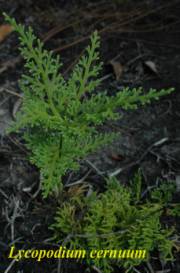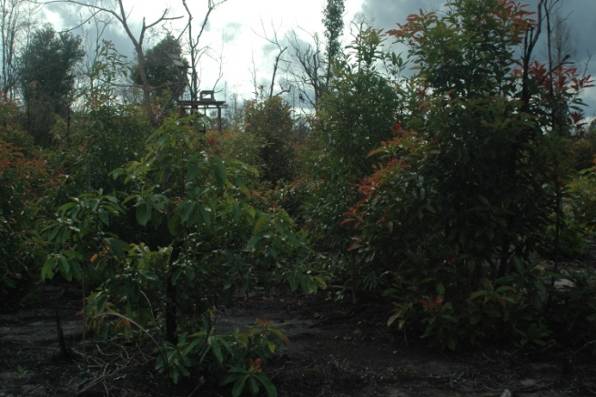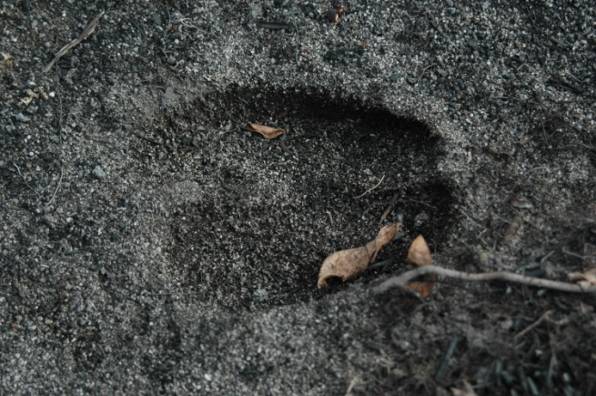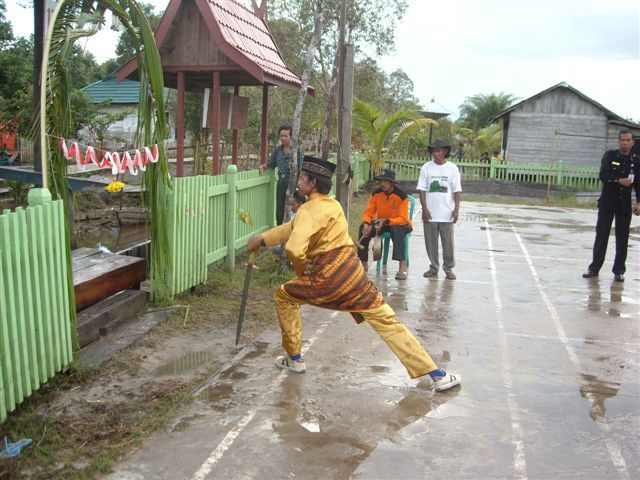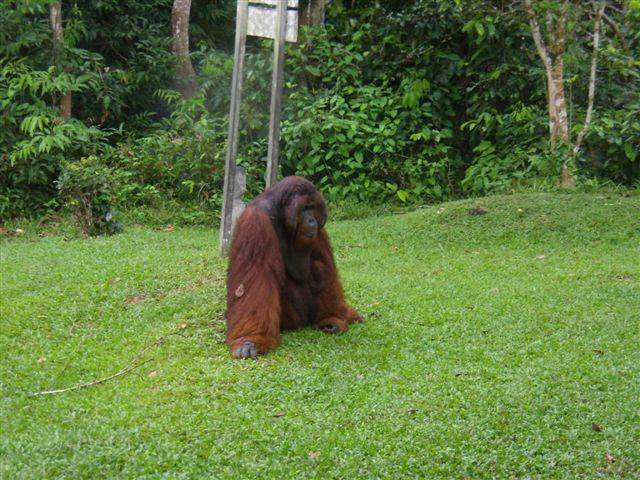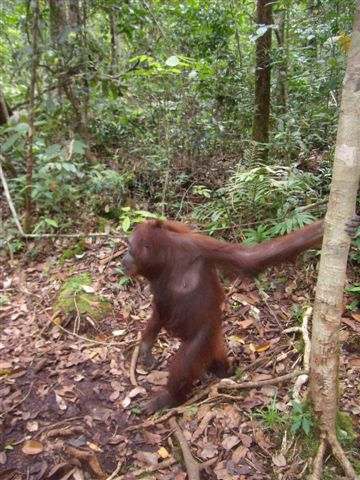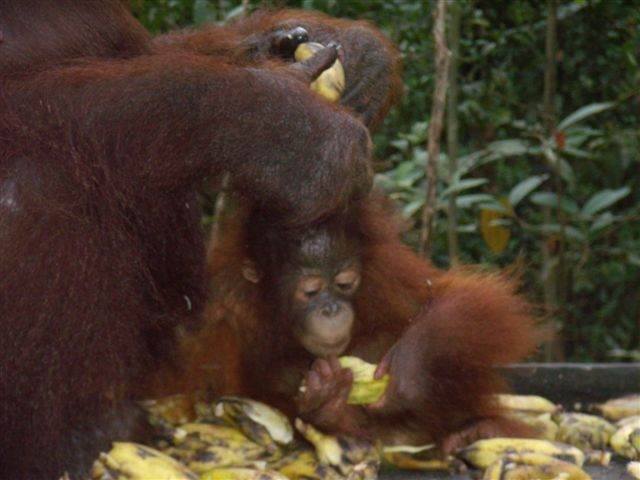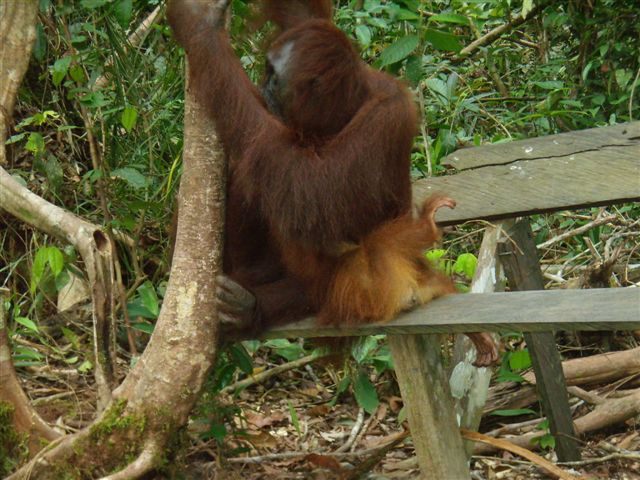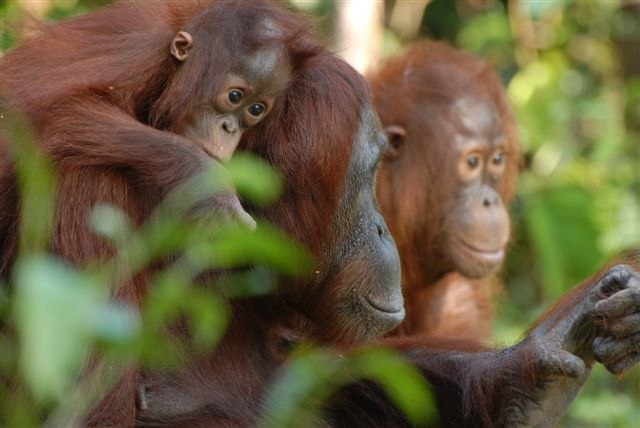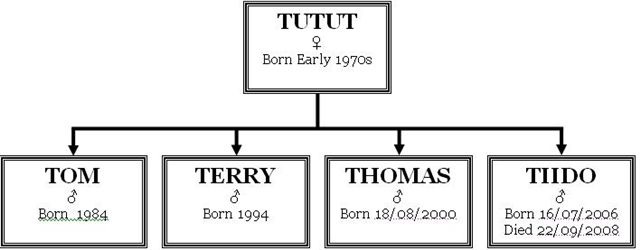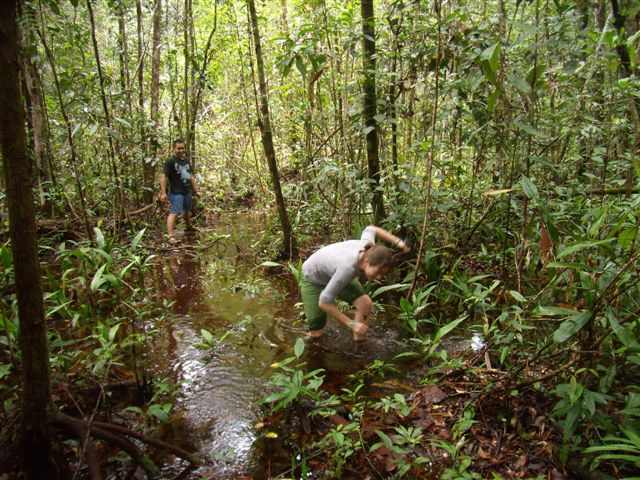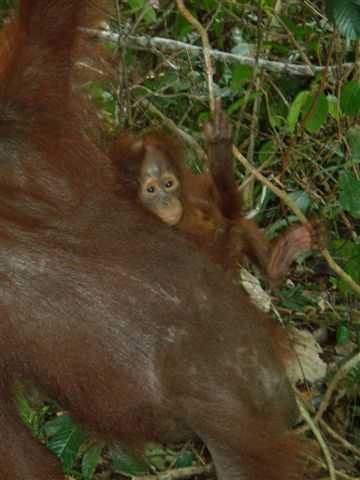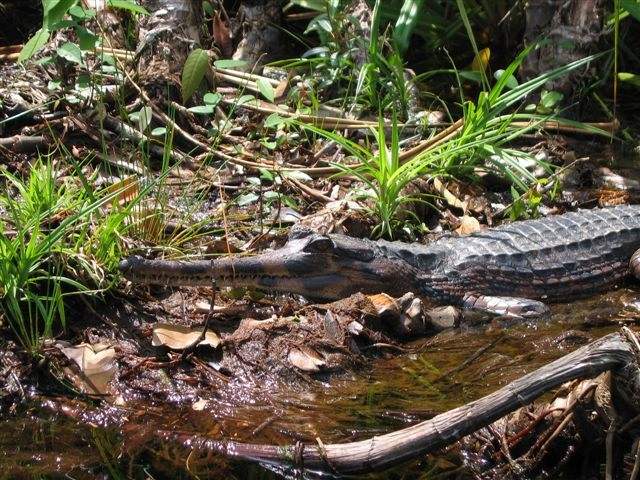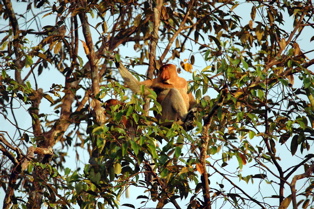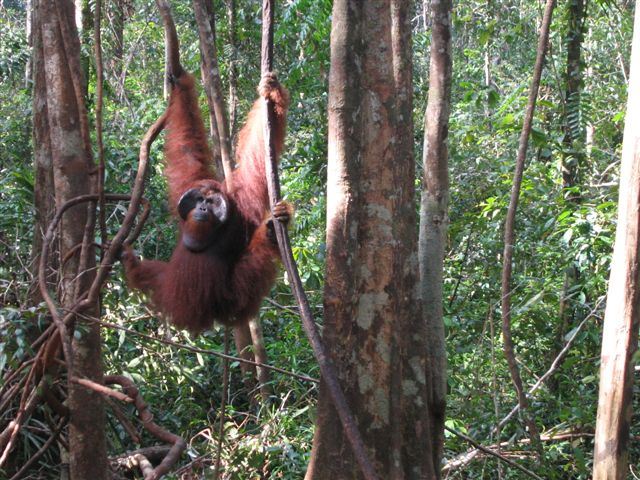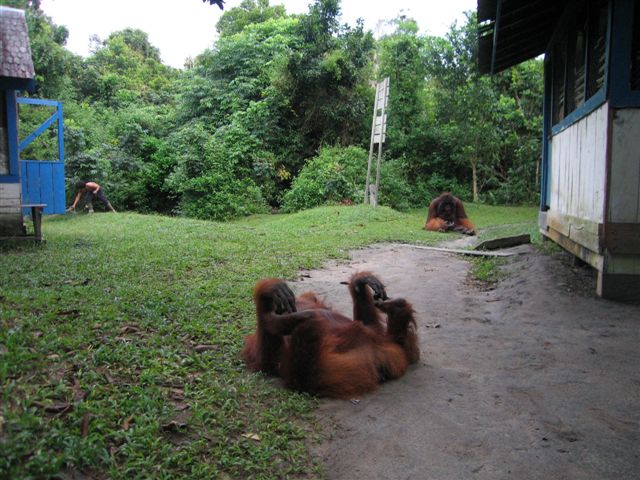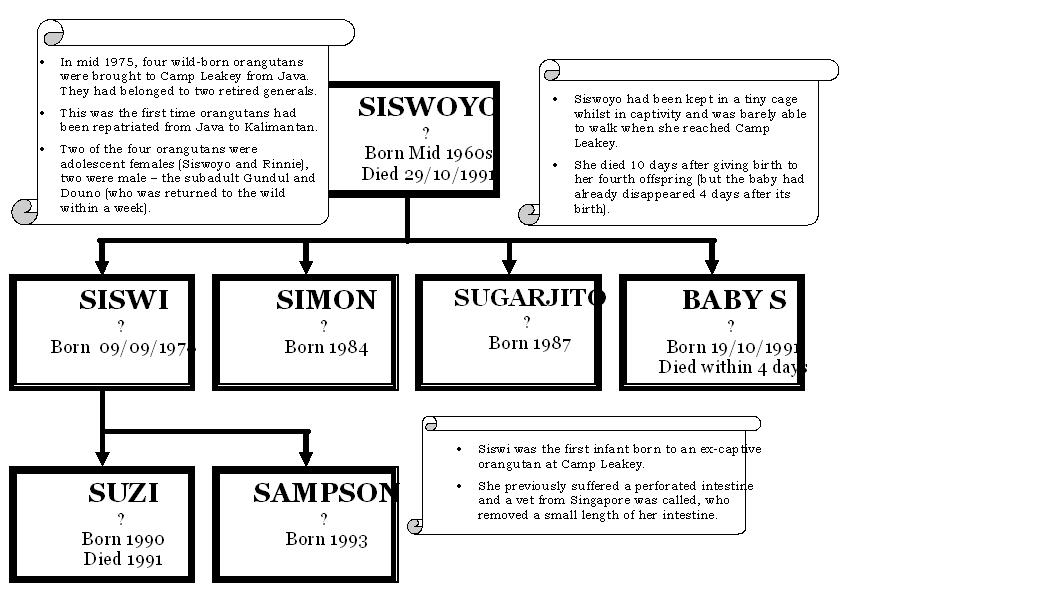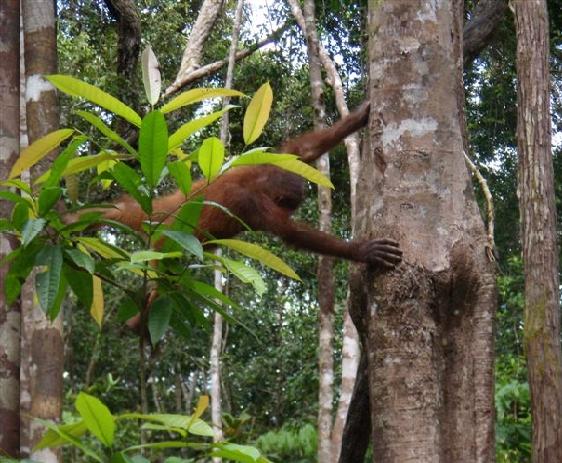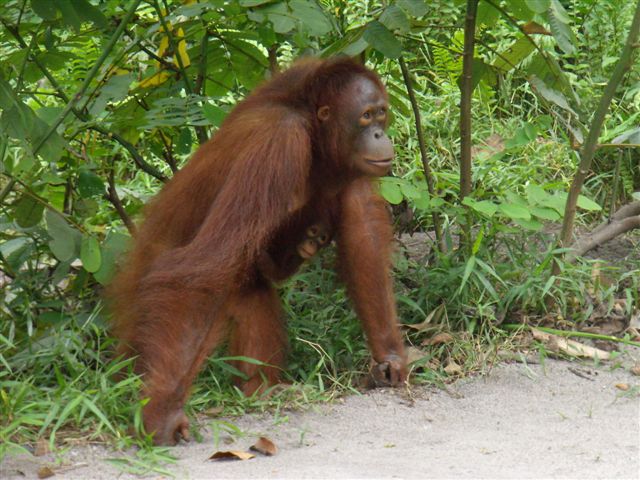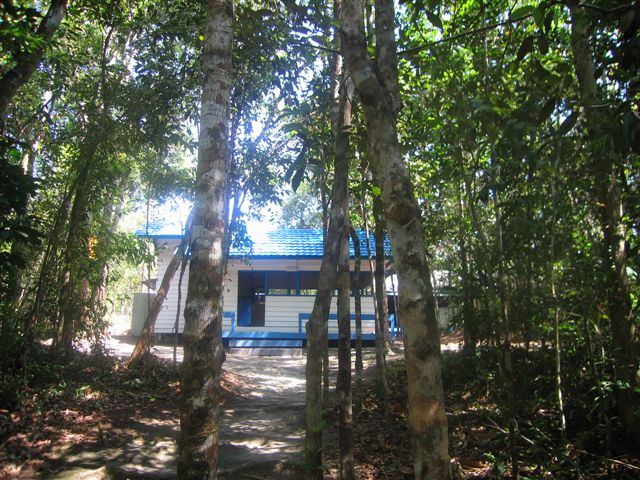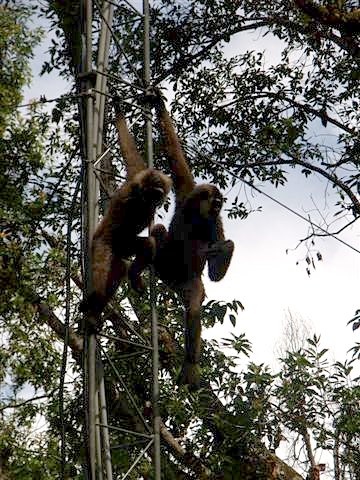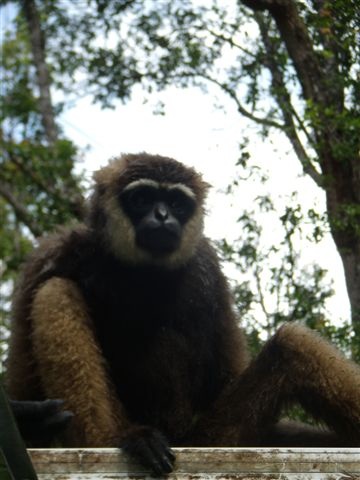The Orangutan Foundation is proud to support Indonesian students conducting research at Pondok Ambung Tropical Forest Research Station in Tanjung Puting National Park, Central Kalimantan, Indonesian Borneo. We want to encourage and help young Indonesian scientists and researchers. 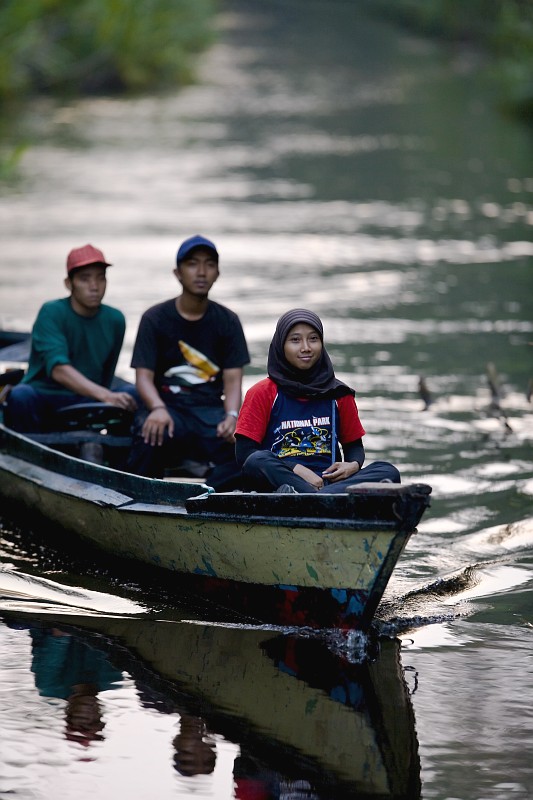 Yusi (at the front) and Harri (in the middle) conduting their research in Tanjung Puting National Park. Photograph by Brian MatthewsIn 2009, we provided two grants, one to Yusi Indriani for her research into the diversity of butterfly species around Pondok Ambung and one to Harri Purnomo for his research into the diversity of bird species. The students spent two months at Pondok Ambung conducting their research.
Yusi (at the front) and Harri (in the middle) conduting their research in Tanjung Puting National Park. Photograph by Brian MatthewsIn 2009, we provided two grants, one to Yusi Indriani for her research into the diversity of butterfly species around Pondok Ambung and one to Harri Purnomo for his research into the diversity of bird species. The students spent two months at Pondok Ambung conducting their research. 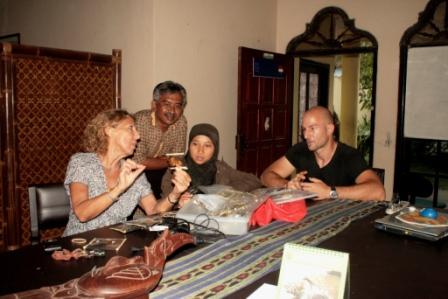 Yusi Indriani (in the middle) presenting her research results to Ashley Leiman (left), the Orangutan Foundation Director, Rene Bonke (right), a German Tomistoma researcher and Hudi DW (just left of centre), the Orangutan Foundation Programme Coordinator in Orangutan Foundation Pangkalan Bun office.
Yusi Indriani (in the middle) presenting her research results to Ashley Leiman (left), the Orangutan Foundation Director, Rene Bonke (right), a German Tomistoma researcher and Hudi DW (just left of centre), the Orangutan Foundation Programme Coordinator in Orangutan Foundation Pangkalan Bun office. Yusi recorded over 80 butterfly species. Orangutan FoundationI hope to bring you more news about Pondok Ambung and its amazing wildlife soon.Thank you,Hudi W.D.Orangutan Foundation Programme Co-ordinator
Yusi recorded over 80 butterfly species. Orangutan FoundationI hope to bring you more news about Pondok Ambung and its amazing wildlife soon.Thank you,Hudi W.D.Orangutan Foundation Programme Co-ordinator
Exploding Fruit!
During the Steppes Discovery study tours (August and September 2009), Ashley Leiman, the Orangutan Foundation Director, played a joke with the “strange fruit” of Tanjung Puting (Indonesian Borneo) forest!The outside of the fruit looks very strong and hard. Ashley asked "who can break it with just your thumb?" The study tour participants tried to push their thumb into the fruit with all their power and then...Puffff….the fruit suddenly explodes over them. Exploding fruit - a study tour participant falls for the trick as the inside of the fruit explodes over his face! Photo by Orangutan Foundation.Greetings and huge thanks to all of the study tour participants from Orangutan Foundation Pangkalan Bun office, your support and donations are very helpful for orangutan and its habitat conservation and also for the local community.Regards,Hudi WD(Orangutan Foundation Programme Co-ordinator)
Exploding fruit - a study tour participant falls for the trick as the inside of the fruit explodes over his face! Photo by Orangutan Foundation.Greetings and huge thanks to all of the study tour participants from Orangutan Foundation Pangkalan Bun office, your support and donations are very helpful for orangutan and its habitat conservation and also for the local community.Regards,Hudi WD(Orangutan Foundation Programme Co-ordinator)
Forest regeneration at Pondok Ambung - a year after the fires.
About a year ago, almost seven hectares of forest behind the Pondok Ambung Research Station was burnt to the ground (see post Fires in Tanjung Puting National Park). This was attributed to human carelessness (not the Pondok Ambung staff, we should note!), and favourable dry conditions. A burnt forest patch however, when left alone, regenerates and a vegetation survey was conducted in February 2009, at the burnt area, to see what had indeed grown back. Field manager for Pondok Ambung, Mr. Devis, noted that the dominant plant types in the recovering burnt area are the ferns, or more specificially the Gleichenia linearis (tree fern) and Lycopodium cernuum (club moss).
Lycopodium cernuum (club moss)
The grasses and sedges are also growing back (Digitaria ischaemum, Sorghum halepense, Pennistrum purpureu, Eleocharis parvula, Cyperus kyllingia, Cyperus distans and Cyperus paniceus), along with the shrubs (Melastoma malabathricum, Ochthocharis borneensis, Achasma coccineum Val. Blumea balsamifera).
The trees as well are making a comeback (Schima wallichii korth, Garcinia sp, Rhodamina cinerea, Eugenia sp, etc.). The evergreen tree (Schima wallichii korth) dominates the rest of the tree types.
Schima wallichii korth is the dominant tree species
It’s not just good news for vegetation – the newly growing area is also attracting deer who favour open habitats for grazing.
Deer track
We will continue to monitor the changes of this recovering burnt area. With each new seedling pushing its way through the soil, one is reminded that this damaged patch of forest, as with the other fire-damaged forests elsewhere in Borneo, could come back to life, if it is left alone.
The forest just after the fire.
Forest recovery one year on. All photos by Devis Rachmawan.
Thank you very much Nicole D and Tal B for your recent donations. We are currently trying to raise $250-300 to buy two digital cameras (see post Meet our new vet for the orangutans of Lamandau Wildlife Reserve).
Thank you,
June Rubis
Video Clip Featuring Wildlife of Tanjung Puting
Very quickly, if anyone would like to see Tanjung Puting National Park, one of the protected areas in which we work, then a short video clip has been released by a German film company who made a film about Tomistoma crocodiles last year. The narration is in German (which will probably be OK for our Swiss friends :-) and an English translation to follow shortly) but the pictures speak for themselves. Its shows orangutans, proboscis monkeys and Pondok Ambung Research Station.Here is the link: http://www.br-online.de/bayerisches-fernsehen/welt-der-tiere/sunda-gavial-krokodil-sumatra-ID1234357757657.xml
A Remarkable Encounter with an Orangutan
During the late 1970s & early 1980s Dr Gary Shapiro taught America Sign Language (ASL) to some of the ex-captive juvenile orangutans at Camp Leakey in Tanjung Puting National Park. His star pupil was, beyond any doubt, Princess. The connection between Gary and Princess continues to run deep. Gary once said, as part of a sworn testimony no less, he had two children: his biological son in the US and an adopted orangutan daughter in Borneo.

Princess and her baby Percy
Anyway, I digress. I have my own Princess story which I was reminded of today and thought I would share with you.
One afternoon, a couple of years ago, an assistant and I were leaving Camp Leakey walking down the jetty to where our boat was waiting. I was carrying a bottle of water. Ahead of us, Princess and Percy sat on the jetty. As we approached, they moved politely to one side. Princess then very obviously made a fist with her thumb extended, and raised the thumb to her lips; the ASL sign for drinking.
It was incredibly touching and remains one of my favourite orangutan memories. There was no doubt Princess was trying to communicate with me. What is more she was using a human language, not her own. That she could remember the language after so long only shows her remarkable intelligence. There was also sensitivity in her actions; if she had wanted the water she could have just taken it. In the twilight of a day, which was also the twilight of my thirties, an orangutan asked me for a drink of water, which I gave her, and I sat next to her as she drank it.
You can find out more about Gary’s work at Orangutan Republik
A wild orangutan
Are you familiar with the concept of speaking too soon? Well, last week it worked in my favour. As we travelled up to Pondok Ambung Research Station, I said to my colleagues, “It’s been ages since I saw a wild orangutan along the river”. Literally, not a minute later there was this young one.

Adolescent wild orangutan at the edge of the river in Tanjung Puting National Park.
It was impossible to tell if the orangutan was male or female but its size suggested it was an adolescent making its first forays away from its mother.
The orangutan is right in the middle of the photo - looks like a dark bundle!
Can you see the orangutan?
Seeing any orangutan is great but we all especially love seeing wild ones, as opposed to the rehabilitated ex-captives seen near to the camps or in Lamandau. Anyway, I am now saying “It’s been ages since I saw a river dolphin….”
National Park Visit
I am sorry for the long silence – I had a fantastic break with my family in Australia. I hope you all had a similarly good end to the year. I actually got back to Indonesia on 9 January but had to spend a frustrating week in Jakarta; the traffic jams in the city are something else! Anyway, I arrived back in Pangkalan Bun last Thursday and, you’ll be pleased to know, I wasted no time in getting back into the forest. Yesterday, the National Park office hosted a visit by the Bupati, the head of the local Government. There was a cast of thousands; well 67 to be precise but the orangutans did not seem at all fazed.
Visit to Camp Leakey organised by the National Park Office.
There were lots of orangutans about including Tom who remained incredibly cool despite the crowd of onlookers. Even the gibbons came in.
Feeding Site - Camp Leakey
After everyone had moved back to Camp I stayed on at the feeding site as there was a new sub-adult male at the feeding platform. The Assistants tell me it is Popeye, the son of the wild female orangutan Peat. Ashley and I can remember following him when he was just an adolescent. Unfortunately, it was getting very dark and overcast by then so my pictures don’t do the scene justice.
There are in fact three or four orangutans in the photo spread out through the trees - you might be able to just work them out.
The day ended in a local village with a display of traditional dancing. All in all it was a fine welcome back!
Brigitta - thank you very much for you recent donations we really appreciate your support.
Orangutans and water - an unusual mix
Thank you for all your comments and I'll do my best to respond to them soon. Another interesting thing happened on Sunday at Camp Leakey: Siswi almost completely submerged herself in water. Orangutans can’t swim though they do wade. The rehabilitated, ex-captives at Camp Leakey will also play with water but that is probably a behaviour learnt from watching the staff. What made Sunday interesting was that Siswi spent so long in the water. She sat there for a good fifteen minutes and actually bobbed up and down so the water rose up to her chin.
Siswi - adult female orangutan in the river.
I am quite convinced she was simply trying to cool off. However, that does not fully explain a) quite how an orangutan’s natural wariness of water could be so totally overcome; let’s not forget there are crocodiles in these rivers and b) how an orangutan who instinctively shelters from rain, which makes them cold, would on another occasion use water for exactly that purpose.
Siswi sitting in the river
Who knows whether Siswi would have sat in the water for so long if we had not been there and it is not a huge intellectual leap to realise water makes you cold and you can choose when you want to be cool or dry. However, none of that dry scientific reasoning detracts from the interest: orangutans are fascinating!
Interesting orangutan behaviour
Firstly, a big thank you to Brigiatta for your monthly donation and Maciej for your donation of $100. As you recently visited Tanjung Puting National Park and Camp Leakey this post should hopefully be of interest to you. In July, we discussed why the orangutan Riga shared her food with her mother, Rani. The reason may be biological or social but what is certain is that it is a rare event between adult orangutans; which is why it was surprising to see it happen again on Sunday – but this time with another twist.
Tom - dominant male
Tom is the undoubted King of Camp Leakey; the dominant male. He doesn’t have to share anything with anybody if he doesn’t want to. On Sunday, he sat down with his bucket of milk and proceeded to slurp away at it with Siswi looking enviously at him. Tut then came up, she had not been to the afternoon feeding so may have been hungry. Tut is Tom’s mother but subordinate to Siswi, so she approached warily.
Tom, however, passed over the bucket without hesitation (and all Siswi could do is continue to look on greedily!).
But what made all this doubly interesting is that it points to an answer to one of the big remaining questions of orangutan research: do they recognise their own parents/offspring? In reality, there is no more reason for Tom to share his milk with Tut than with Siswi (indeed, Tut is not in season but Siswi could be) and yet he did willingly. Why? It would be interesting to think Tom knows his mother and that was why he acted favourably towards her but like so much about orangutan behaviour we still have a lot to learn.
Thank you,
Stephen
PS Apologies for the rain spot on the photo.
Camp Leakey Tanjung Puting National Park
Thanks to Georgina Kenyon who has written this short piece for us about her experience making the BBC radio programme. "It’s embarrassing to say but I can’t remember being that interested in orangutans…until I saw the big male Kusasi coming straight for Stephen and me at the feeding platform at Camp Leakey.
What an animal!
I also loved walking through the forest, following the other orangutans as they were looking for food– those four hands and those eyes!
I’ll always remember my stay that night on the klotok and listening to the sounds of the Borneo jungle – the rowdy chainsaw beetles and the gibbons at first light and watching the butterflies and the birds of prey.
I have always thought the issues surrounding conservation can be very complicated - so many threats, so many issues.
Yet I was impressed by the pragmatism of the staff at the Orangutan Foundation; they made all the problems facing the jungle appear manageable.
A big ‘thankyou’ to all the team at the Orangutan Foundation-everyone went out of their way to help me make the BBC radio programme."
One year on…
It has been nearly a year since Stephen started this blog on the 23rd November 2007 and so far you have donated US$4,680 towards our programmes in Central Kalimantan, Borneo. This money has been spent on; buying medical supplies for the orangutans at the Orangutan Care Centre and Quarantine; for enclosure repairs (remember the escapees!); fire beaters and equipment to tackle forest fires in Tanjung Puting National Park; and more recently the new feeding system for released orangutans in Lamandau Wildlife Reserve. THANK YOU! THANK YOU! THANK YOU! We are hoping to reach the $5,000 target by the end of November. What we really need at the moment or what the Indonesian field staff need is new equipment. On our donation bar under One Time donation there are the options Uniforms or Compass & Wrist Watch. A donation for one of these would be a practical and useful contribution towards our work. Please consider a donation to support our work this month.
On behalf of Orangutan Foundation in Indonesia and the UK thank you for your interest and support over the last year.
Cathy
(UK office)
Orangutan Awareness: A Personal View
After my last my about the day at Camp Leakey I received a short email from the Office reminding me that I was supposed to be writing about Orangutan Awareness Week! Whoops. Sally and the Yayorin team will be able to tell you of all the activities. I thought I would offer a simple, personnel view on why I have always supported the week.
We all need trees.
We know how to save orangutans – you just stop chopping down the forest and hunting them. Leave them alone and they will be just fine. But that isn’t happening. The situation here in Borneo and in Sumatra is very bad. Just yesterday, we were told of a proposal to convert another 10,000ha (100km2) into an oil-palm plantation. Not all of that land is forest, but a lot of it is and I guarantee there are still orangutans, monkeys, hornbills and a host of other birds and smaller mammals living there.
Spot the difference.
What lay behind the local government’s decision to give up more forest? There are a host of reasons but perhaps the ultimate explanation is simply that the return from logging and palm oil translates to cash whereas the returns from standing forest are often intangible. That is a balance that has to be rectified. Which is exactly why Orangutan Awareness Week is so important:
- The loss of orangutans and their habitat is irreversible.
- Consumers need to be aware of the true cost of the products they buy. The driving force behind the move towards sustainable palm oil is consumer pressure.
- National governments need to be aware of the impact of the trade decisions they make. The US is to be applauded for its recent amendment to the Lacy Act which will go a long way to stopping the import of illegally felled timber.
- Here, the local Government needs to be aware that floods which plague the riverside communities are linked to deforestation upstream.
- Farmers need to know that there are alternatives to slash and burn agriculture, that their household income can improve by better use of the land.
- There are huge ethical issues involved in the loss of orangutans as a species let alone the abhorrent killing of individuals. I feel this keenly and am sure many of you do too. However, climate change has now made the loss of their habitat an ethical issue too: tropical forests can play a significant role in mitigating against climate change. Truly, saving orangutans can now help humankind.
Without Orangutan Awareness Week how many people will know of the link between this smoke from forests and the rise in sea level? Without the work of groups like Yayorin how many people will learn it doesn't have to be this way?
We all have to be involved in this and that’s why Orangutan Awareness Week is international. The bottom line is whether to destroy forests or to save them will remain a choice that many people will have a hand in making. Only with complete awareness will we all make the best choice and orangutans are the perfect flagship or ambassadors for the forest.
What we all need - forests "lungs of the planet"
There are half-a-dozen or so places, Tanjung Puting National Park and the Lamandau Wildlife Reserve among them, that are safer today than they probably have been at any time for the past thirty odd years. Saving them has been a battle and we are now working on securing the peace. We can be proud of those successes but they are not enough. Certainly, we can not be drawn into trading off a few parcels of safe forest for devastation elsewhere. As the 10,000ha mentioned above shows, the battle lines are still being drawn. That has to stop.
The battle lines
I was touched to see the blog by Art for Gorillas on the Wildlife Direct. ). If children in Rwanda can be galvanised to care for orangutans what can’t be done?
As always, thank you for your support,
Stephen
Orangutans at Camp Leakey
I began my monthly report to the UK office by saying “as September was quiet, so October was busy” and I still think that was an understatement! We seem to have been on the go constantly since the holidays which marked the end of Ramadan at the start of October. You will be pleased to know however I have had the chance to spend some of that time looking at orangutans. And yes, I had my camera.
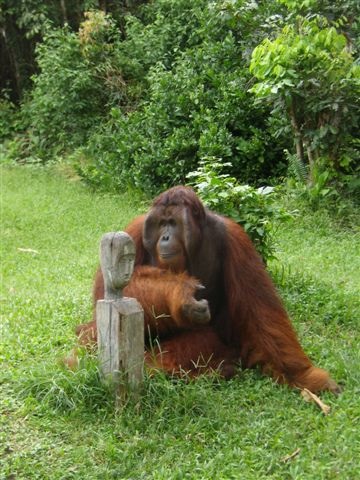
One afternoon spent at Camp Leakey, in Tanjung Puting National Park was particularly memorable. There were very few visitors and it felt as if we had the forest to ourselves. Tom, the dominant male, was around, looking as big as ever.
However, it was Princess and her baby Putri who made the real impression. Princess actually walked to the feeding site with us and when I say walked I mean walked. She was not bipedal (walking on two legs) the whole time but she did amble in front of us for a time. That was her chance to show off!
Next it was Putri’s. Once she and her mum had had their fill, they relaxed on the benches on which visitor’s usually sit. Princess began grooming Putri who lay back and loved it. No doubt, if she had been a cat she would have been purring. She got so comfortable when she rolled over she almost toppled off the bench.
Above us two other youngsters played high in the trees (apologies for the dark photo!).
However, the sun was setting and storm clouds building, so we had to leave the orangutans in the forest and hurry back to camp. We made it just before the heavens opened.
Short film of Tanjung Puting National Park
Please take a few minutes to view this short video 'Fragile Haven' about Tanjung Puting National Park by David Willis (it may take a few minutes to load but is worth waiting for). Tanjung Puting National Park is one of the world's largest areas of protected tropical peat swamp and heath forest. The Park has more than 4,000 orangutans making it one of the largest remaining populations in Borneo. Please click on this link (Protecting Tanjung Puting National Park) to read more about the Park and our work there.
Sad and Rare Death of a Baby Orangutan Killed by a Pig.
Tragedy struck us again this week with the news from Camp Leakey, in Tanjung Puting National Park, that Tut, a female orangutan, had her two-year old baby killed by a pig. It appears the pig and orangutans were near to each other in Camp when the pig turned and snapped at Tiido, catching the young orangutan around the head. One bite was enough. Tut immediately picked him up and when the assistants rushed over they could see Tiido was still alive but, within an hour, he was lying limp in his mother’s arms.
I am afraid I don’t have a recent photo of Tiido but if you zoom in on the photo below, of Tut sitting by the tree, you can see a tiny arm across her waist. That was Tiido when he was new born.
Peter’s photos show him when he was a year old. I am afraid I don’t have more recent photos.
Tut with her beautiful baby Tiido. Photo by Peter Ellen.
Tut was released at Camp Leakey in the very early days of Biruté Galdikas' research there. Indeed, she is the mother of Tom the present “King of Camp Leakey". Tiido was her fourth son.
Bornean Bearded pigs are common in this area primarily because they are omnivorous; they will eat anything. This means they can survive in a wide variety of habitats including oil palm plantations – where they are considered pests – as well as in dense forest. They tend to hang around the orangutan feeding stations so they can scavenge left-overs or dropped fruit.
They are temperamental and have been known to chase orangutans, probably in the hope the orangutan will drop the food they are carrying. In 1985 Biruté Galdikas reported a pig killing a young orangutan. But this week’s incident was the first of its kind in over 20 years.
Regarding Tiido’s death, I know people will say “that’s life; it is nature red in tooth and claw”. In my heart of hearts I agree with them. But I still feel sick and a little heartbroken (I threw a branch at the first pig I saw on Saturday).
To end on a positive note, thank you very much Maciej G. for your donation of $130. This is hugely appreciated and will go towards our new feeding system in Lamandau.
A short trip in Tanjung Puting National Park
Last night, before I was side tracked into giving you an update on Zidane (who I saw again today and he is still looking good), I thought this story of a weekend trip to Tanjung Puting National Park would be quite good fun. Now I have started it, I have a feeling it is going to be dull! As I've mentioned Elly from the London office is out on a short visit. Devis and I took her up to Pondok Ambung and Camp Leakey. The night at Pondok Ambung was great as ever and nothing is better than waking to the sound of gibbons singing.
After breakfast we decided to go for a short walk to have a look around. Besides one glorious veiled-lady fungus (beautiful but very smelly) and some pitcher plants, we did not see too much besides water.
Veiled-lady fungus
Pitcher Plants
All the swamps are full. I was the first to stumble in but, I am pleased to say Devis and Elly quickly followed suit. Also, as I was the one with the camera my mishaps are not recorded :-)
(Devis insists I tell you that, in the photo, he is not in fact falling over, but picking up a stick. I leave it to you to decide!)
We then went up to Camp Leakey. I hope next year we can update the displays in the Information Centre which are starting to deteriorate and look a bit tired. I was attempting to show this to Elly but understandably she was far more interested in the orangutans.
With Gara and her new baby around, who can blame her?
Add Power To Our Research
Pondok Ambung, our research station in Tanjung Puting National Park, has been mentioned quite a bit in my blog. In the late 80's, Pondok Ambung was established as a proboscis monkey research site but by the end of 90's it had been badly damaged by illegal loggers. The Orangutan Foundation's team of volunteers repaired the site in 2001 but it remained abandoned until 2005 when the Rufford Maurice Laing Foundation awarded us a grant for its complete renovation.
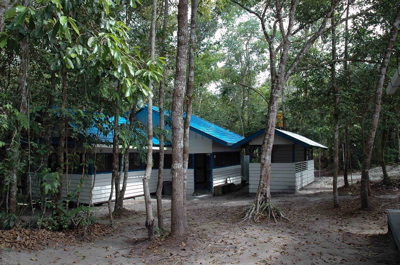
And this is what we did.
The station requires a new solar power set. Solar is the only source of power providing electricity for the station. A new solar set costs $600 and any donations towards this amount would be hugely appreciated. So far the running and maintenance of the station has been entirely funded by the Foundation or from fees received from researchers staying at Pondok Ambung.
 Recently, Pondok Ambung was used as the base for the “Orang-utan ‘08” expedition from the University of Aberdeen, Scotland. A team of four undergraduates led by Graham Banes spent eight weeks in Tanjung Puting studying the effects of disturbance, particularly forest fires, on the distribution and density of orangutans. Encouraging scientific research in Tanjung Puting National Park creates the knock on effect of increasing support for its protection.
Recently, Pondok Ambung was used as the base for the “Orang-utan ‘08” expedition from the University of Aberdeen, Scotland. A team of four undergraduates led by Graham Banes spent eight weeks in Tanjung Puting studying the effects of disturbance, particularly forest fires, on the distribution and density of orangutans. Encouraging scientific research in Tanjung Puting National Park creates the knock on effect of increasing support for its protection.
Here are some of the incredible species that have drawn researchers to Pondok Ambung so far.
Malaysian False Gharial (Tomistoma schlegelii)
Proboscis Monkey
Tarsier
Tropical Pitcher Plant
And of course...Orangutans!
Thanks for your comments on my last post - I've just about recovered!
Siswi - Another Camp Leakey Character
Last week Brigitta asked me to give her regards to Siswi. Unfortunately, I have not managed to get out of the office (hence this week’s blog, which has been more about individual orangutan histories than actual news from the field!). However, I thought I would tell all of you about her because, like Kusasi, she is one of Camp Leakey’s characters. Most visitors to Camp meet her and she’s pretty noticeable.

Siswi has a distinctive gait, a unique habit of lying on her back holding her feet and, if there is a male around, she’s almost guaranteed to put in a show.
People may consider her “rotund” but that does not appear to diminish her sex-appeal; she frequently consorts (the name given to the temporary male – female pairings, when a female is in season) with Tom, whereas a few year’s ago, she was definitely Kusasi’s girl. Indeed, without trying to keep going on about the film “Kusasi: From Orphan to King” there is a delightful scene where Siswi is rolling along in front of Kusasi as he walks through the forest.
What made Siswi famous from the outset was that she was the first ever offspring of a rehabilitated orangutan at Camp Leakey. Siswoyo was released by Biruté Galdikas in 1975. On the 9th of September 1978 she gave birth to Siswi, evidence that once-captive orangutans can return to the wild. Because of this, the first release camp in the Lamandau Wildlife Reserve is called Camp Siswoyo.
Attached is Siswoyo’s family tree. My apologies that the text appears to have jumped inside the boxes; I am no-one’s idea of a graphic designer! You may need to click on the family tree to read it.
Monitoring released orangutans
I see a number of people have asked how we monitor the orangutans once they have been released into Lamandau. There is nothing technical involved: our field assistants follow the orangutans from sunrise to sunset (or as we say, "nest to nest") everyday for a week. If after that time it is clear the orangutan has adapted to life in the forest, they will then be followed occasionally like the other previously released orangutans. If after the first week, the assistants are concerned that the orangutan may not be adapting they will continue to follow he or she for a month. Common causes of concern are the orangutans not making their own nests but choosing to sleep on the feeding platform or making a bee-line for Camp and not exploring their new surroundings. Within the first week, we expect to see the orangutans making their own nest, trying wild food and travelling. Nearly all achieve this.
Most newly-released orangutans tend not to go too far in the first couple of days but then they start to travel further and further. Last December I told you about the release of Sawit and her adopted son Andi. They took off within their first week, probably because Sawit was being hassled by a sub-adult male. The Assistants could not follow her through the swamps to the west of Camp Rasak. However, on 22 April, back they came, still together.
Which brings me onto the last element of the post-release monitoring; the daily supplemental feedings. In Tanjung Puting, where orangutans were released from the early 1970s to the mid-90s, the rehabilitants are offered food once a day. In Lamandau food is provided twice a day. This serves three purposes: it keeps up the nutrition levels of the released orangutans; it decreases competition for scare food resources with wild orangutans, gibbons, hornbills, and other wildlife and finally it enables us to monitor the orangutans’ development. All individuals coming to the feeding stations are recorded; over the course of a year, at least half of all released orangutans are seen. The Assistants also note whether they are consorting with the opposite sex, pregnant or with an infant and their general health.
For example, Boni who was released at the same time as Sawit and Andi came into feeding 26 times during April, and then every day in May and June. Lady Di, whose picture I showed you in April, was around for 28 days in April, May and June but Hongky was there for just 9 days in April, 14 days in May and 25 days in June.
In answer to “Rick, El Paso, TEXAS” question about the availability of this data, I am afraid to say it is not available online. We produce quarterly reports, in Indonesian, covering this information but the reports are for the Forestry Department and our own internal use. However, Tigor who manages the Lamandau Camps is providing information about our release program to an Indonesian PhD student at Cambridge University in the UK. So hopefully it will be peer-reviewed and published.
Please keep asking questions and I’ll try to keep answering them! Many thanks.
Tropical Forest Research Station
July has been a busy month, hence my lack of posts (apologies) and it looks set to continue into August. This has definitely been Pondok Ambung’s month. Pondok Ambung is the Tropical Forest Research Station we operate inside Tanjung Puting National Park.
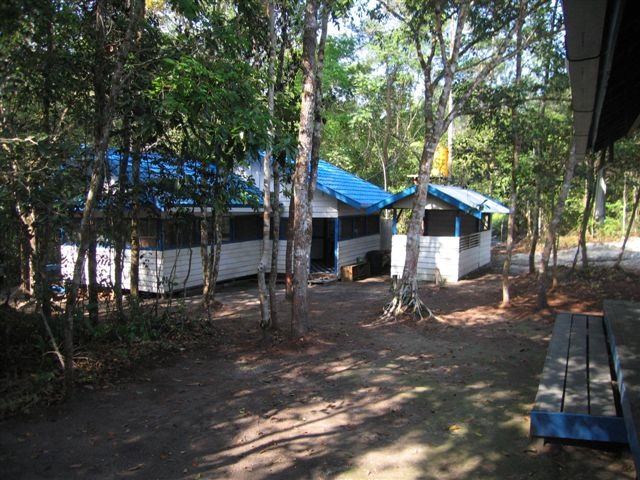
Pondok Ambung is set in a beautiful location on the Sekonyer River, TPNP.
I have already told you of Rene’s study on crocodiles but I think it completely slipped by to tell you that the University of Reading's ‘Summer School’ were here earlier this month. This is the second year, Reading University have run a ten-day field course at Pondok Ambung. It is always great to see students getting out of the classroom and into the forest. I hope it inspires them. They were certainly captivated by the orangutans and gibbons.
Pondok Ambung visitors; orangutans, gibbons, and humans -whose watching who?
And just to prove there are always new experiences to be had, the day Brigitta (who contacted us through Wildlife Direct) was with us at Pondok Ambung, we found a tree that had been absolutely torn apart. You will have seen photos of the damage sun bears can do to trees in one of my earlier posts. Orangutans will also tear off bark to either get at sap or insects. But, on this tree, half the bark had been shorn off and huge chunks of heartwood pulled out. If it was an orangutan or a bear, I would not want to meet them!
It was Rene who gave us the answer: the tree had been struck by lightening (he said there had been an almighty thunder clap and lightening flash the day before). That was why the wood appeared to have exploded outwards. Still it was incredible there was no sign of burning. Despite the downpour, I would have thought a million plus volts would have at least singed the leaves…


